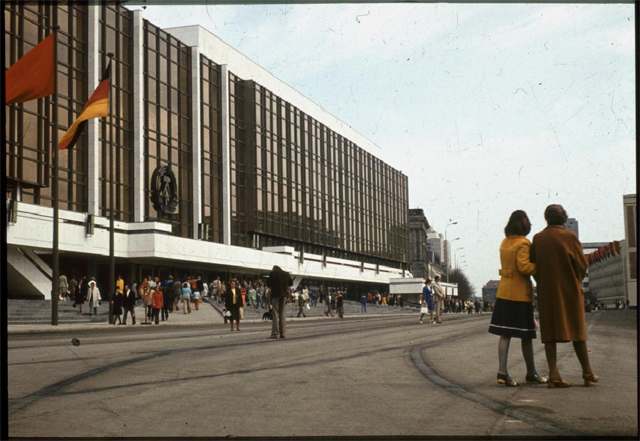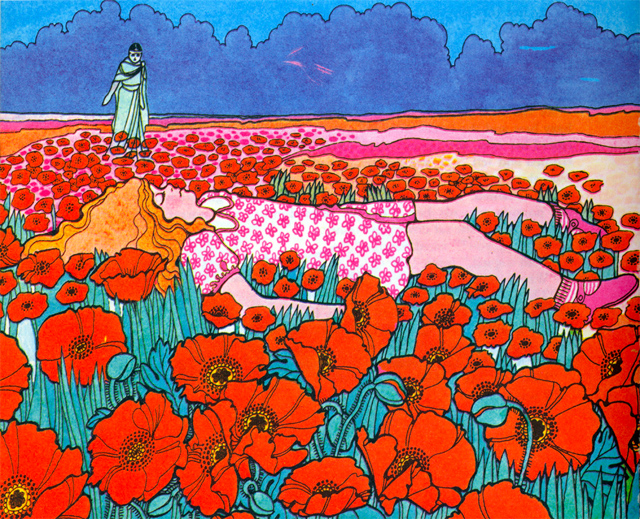Spectres never truly vanish, and hauntology’s modus operandi is precisely the spectral realm. This puzzling cultural micromovement took its name from Jacques Derrida’s works: the term, originally a pun merging ‘haunt’ and ‘ontology’, predicted a state of civilization endlessly troubled by historical spectres, a destiny which the West would be trapped in after ‘the end of history’. In cultural studies, the term was first used near-simultaneously by Mark ‘k-punk’ Fisher and Simon Reynolds circa 2006, in reference to a then-emerging strain of music. The critics noticed similarities between artists from the Ghost Box Records, Mordant Music, Boards of Canada and eventually Ariel Pink, all pursuing a shared aesthetic of skewed nostalgia, distorted memory, and evocations of the past as a peculiar, slightly uncanny wunderkammer. That was expressed by heavy sampling (1960s and 70s cinema, TV series for children, educational programmes), references to library music, musique concrete or early experiments with electronic music, and a penchant for outdated technology applied to sound.
In the late 1990s, scholar Erik Davis sought a ‘spiritual component’ in new technologies, suggesting that the Internet can be a dimension for mystical experience; hauntology eventually became the most interesting (and most literal) manifestation of his ‘techgnosis’ concept. The movement treats technology as a medium in both senses of the word – ‘a means for broadcasting’ and ‘one who communicates with the paranormal world’. This supernatural element has long been a component of technology: it is said that Thomas Edison worked on a device, which would enable conversation with the dead, while the practice of photography was originally referred to as ‘fixing the shadows’.

As if at a Victorian séance, the hauntologists’ work was inhabited by apparitions, evoked through the medium of old tape recordings and analogue broadcasting. Ghost Box – a name referring to the television set, as Jim Jupp of Belbury Poly explained – reached towards the childhood fears raised by Public Information Films, as well as to the promised land of modernist visions, in which design and architecture contributed to a citizen’s wellbeing. Moon Wiring Club took the concept one step further. In their invented parallel world of Clinkskell, they evoked the occult fascinations of Edwardian eccentrics – a staple of 60s psychedelic design and 70s children’s TV – and added a soundtrack of deliberately wonky, awkward sampledelia.
Hauntology’s subject matter was the subjective area of memory, especially the liminal zones in which the public discreetly saturates the personal. This inclination gave the movement an elusive, amorphous nature, which, fittingly, even the genre’s defining fathers struggled to express. Most frequently applied to music, hauntology also referred often to occurrences described by transpersonal psychologist Stanislav Grof as COEX: ‘constellations’ of dispersed experience from various periods of life, fused together into vivid, complex, quasi-familiar themes. Perhaps, this is a reason why the most successful attempts at grasping the essence of the genre leaned towards the phenomenological: indirect, and conveyed via means of detailed description, experience, example and illustration. Adam Harper used an idyllic postcard of a boy playing with a hedgehog as a symbol of what hauntology expresses: the image’s innocence marred by the fact that it was published in the GDR just before the collapse of the Berlin Wall. Hence, it inadvertently became an artefact of the chaos and danger lurking under Utopia, a certain liquid fear. “This postcard haunts and is haunted. In 1989, its utopian promise haunted a reality that was unable to make good on it, and in turn the postcard was haunted by the increasingly dystopian qualities of reality (…) the postcard is a ghost of the GDR”, wrote Harper.

‘Retromania’, a handy umbrella term coined by Simon Reynolds, is still our zeitgeist, but fashions within this modus tend to come and go. The weirdness of hauntology is not the latest fad anymore, and it seems that its moment has passed. Last year brought new releases by the leading Ghost Box acts, Belbury Poly and The Advisory Circle: both very good, but simultaneously leaving the idiom of hauntology and diverging towards classic folk-psychedelia. And yet, due to hauntology’s spectral nature, traces of the genre will not entirely disappear. In recent months we have even observed hauntology itself slowly becoming spectral: not a vessel for spectres, not an interference signal helping track down the haunting phenomena, but rather the haunting agent itself.
A puzzling latecomer: a project named Public Service Broadcasting, described as an attempt to ‘teach the lessons of the past through the music of the future’. Their Inform-Educate-Entertain LP is heavy-handed in its directness; a literal take on hauntology utilising spoken-word sampling, educational programmes, television and radio excerpts, yet in which all possible nuance is removed from the hauntological template. Ghost Box and Moon Wiring Club managed successfully to employ verbal and visual hints which subtly touched on the uncanny aspects of collective memory. Public Service Broadcasting wear these references as a stiff, uncomfortable retro costume, bringing to mind the image of someone who read a definition of the genre and tried to recreate its qualities via its methodology… without ever having heard the music.
Thankfully, there’s an antidote. The Focus Group, a project of Julian House (Ghost Box co-founder), which preceded the critical definition of the genre, return with their first autonomous release since 2007. In the meantime, House worked with fellow retro-nostalgics Broadcast on the feted ‘Witch Cults of the Radio Age’, and continued to design the covers which contribute to Ghost Box’s singular branding. The Elektrik Karousel, The Focus Group’s new LP, is an evocative, accomplished return to the hauntological universe. The album’s central themes, the carousel – together with the music box – are the most uncanny artefacts of the analogue-era childhood. Full of magical charm and making pretty sounds, yet also prone to terrifying the young through the forced grins of the galloping horses or slowing oddly like a record winding down to a standstill.
All the expected signifiers are in place here: the delights in analogue exploration redolent of the BBC Radiophonic Workshop, retrospective visions of the future, tiny hints of stylish sixties jazz and exotica, baroque-pop arrangements, library music, and last but not least, the uneasy, beguiling vibe. The Elektrik Karousel is slightly more melancholic than House’s previous releases, due in part to the fact that the archaeological work of unearthing the forgotten realms of memory is largely complete. It may also be influenced by Broadcast vocalist Trish Keenan’s death between Witch Cults and the latest album, leaving an elegiac air hanging over proceedings. The Focus Group’s album does exactly the thing which Public Service Broadcasting’s ham-fistedly fails to achieve: distilling the gist of a genre into a concise summary. House collects tiny, unfinished song-trinkets, which together build a poignant sonic sketchbook and, in the classic hauntological tradition, make the familiar strange once more.**
Header Image: Taken from Arnold B. Barach’s 1975: And the Changes To Come. Image courtesy of Derrick Bostrom.















